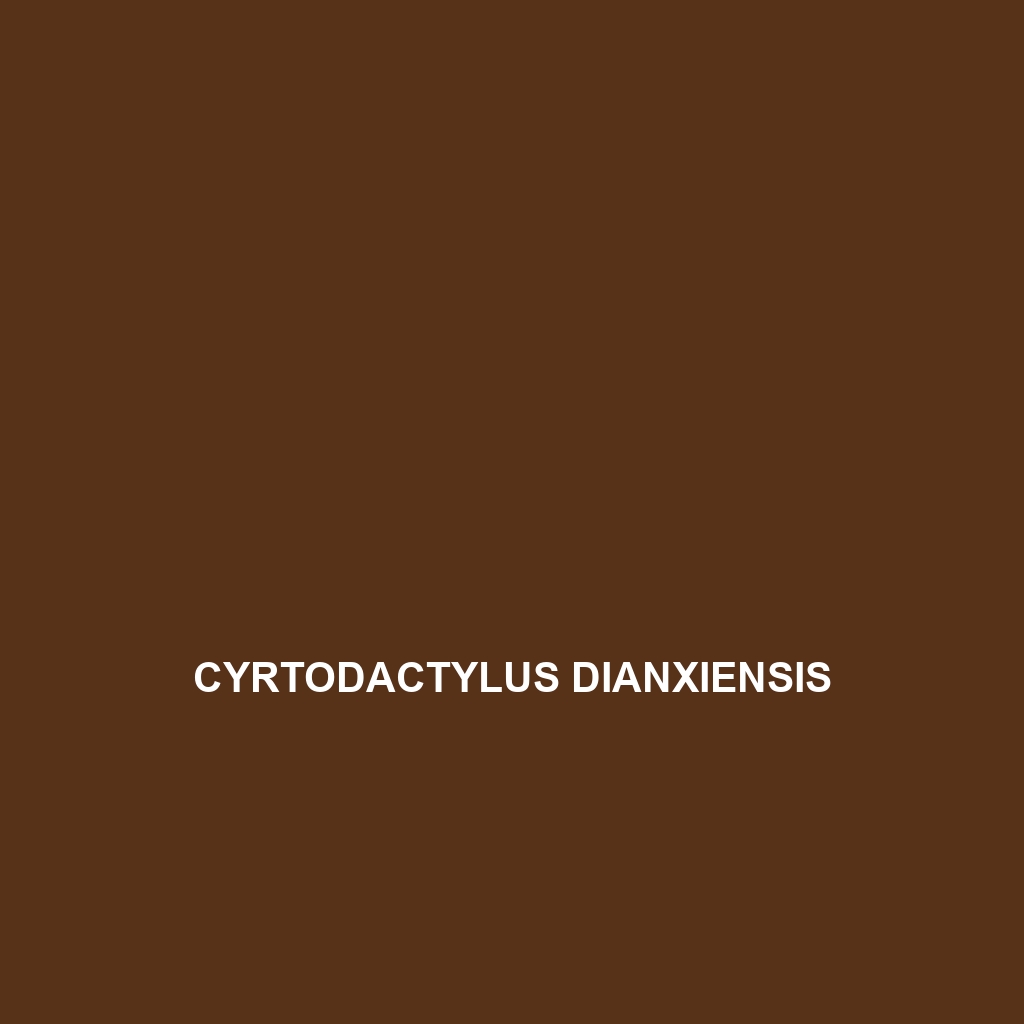-

Cyrtodactylus edwardtaylori
Discover the unique Cyrtodactylus edwardtaylori, or Edward Taylor’s bent-toed gecko, a nocturnal species native to the limestone karsts of Southeast Asia, characterized by its agile climbing abilities, distinctive dark blotched coloration, and vital role in regulating insect populations. Protecting this vulnerable gecko is essential for maintaining biodiversity in its tropical forest habitat.
-

Cyrtodactylus doisuthep
Discover the Cyrtodactylus doisuthep, a unique gecko native to the humid forests of northern Thailand’s Doi Suthep-Pui National Park. With its striking patterned skin, exceptional climbing abilities, and role as both predator and prey, this vulnerable species thrives in rocky habitats and is notable for its nocturnal behavior and fascinating communication methods.
-

Cyrtodactylus dianxiensis
Explore the fascinating Cyrtodactylus dianxiensis, a nocturnal gecko native to the limestone karst regions of southeastern China, known for its remarkable climbing abilities and effective camouflage. With a diet primarily consisting of small insects and a vulnerable conservation status, this species plays a vital role in its ecosystem by controlling insect populations.
-

Cyrtodactylus dattkyaikensis
Discover the unique Cyrtodactylus dattkyaikensis, a medium-sized gecko from the limestone karst ecosystems of Myanmar, featuring striking brown and beige patterns, remarkable climbing abilities, and a diet primarily consisting of insects. This vulnerable species plays a vital role in maintaining ecological balance within its environment.
-

Cyrtodactylus darmandvillei
Discover the unique Cyrtodactylus darmandvillei, a fascinating gecko native to the limestone hills of Southeast Asia, known for its camouflage, nocturnal behavior, and diet primarily consisting of insects. This species plays a vital role in its ecosystem by controlling insect populations and is classified as vulnerable due to habitat loss.
-

Cyrtodactylus cucphuongensis
The Cyrtodactylus cucphuongensis, a vulnerable gecko species found in Vietnam’s Cuc Phuong National Park, features a moderate size of 12-15 cm with light brown to gray coloration, toe pads for climbing, and a diet primarily consisting of insects. Nocturnal and agile, this gecko plays an essential role in its ecosystem by regulating insect populations and…
-

Cyrtodactylus cattienensis
Cyrtodactylus cattienensis is a small, nocturnal gecko native to the evergreen forests of southern Vietnam, known for its distinctive light brown coloration with dark markings, excellent climbing skills, and a diet of insects. This vulnerable species plays a crucial role in its ecosystem by controlling arthropod populations and serving as prey for larger predators.
-

Cyrtodactylus bokorensis
The Cyrtodactylus bokorensis, a vulnerable gecko species found in the tropical rainforests of southeastern Cambodia, measures 8 to 12 cm and features a sandy beige to light brown coloration with dark speckles. Nocturnal and agile climbers, they play a crucial role in their ecosystem by controlling insect populations and serve as prey for larger predators.
-

Cyrtodactylus bidoupimontis
Discover the Cyrtodactylus bidoupimontis, a vulnerable gecko native to Vietnam’s Bidoup Nui Ba National Park, known for its slender body, distinctive olive patterns, and nocturnal hunting behavior. This insectivorous species plays a crucial role in maintaining ecological balance by controlling insect populations in its humid subtropical forest habitat.
-

Cyrtodactylus bhupathyi
Discover Cyrtodactylus bhupathyi, also known as Bhupathy’s Gecko, a medium-sized, nocturnal gecko native to the humid rainforests of Southeast Asia, featuring intricate camouflage patterns, excellent climbing abilities, and a vital role in controlling insect populations within its ecosystem. Classified as “Vulnerable,” this species faces threats from habitat destruction, highlighting the importance of conservation efforts.
Search
Popular Posts
-
Lygosoma corpulentum
Discover the Lygosoma corpulentum, or fat skink, a robust insectivorous lizard native to Southeast Asia’s moist tropical rainforests and varying habitats. With a stocky body, impressive camouflage, and remarkable adaptability, this ovoviviparous species plays a crucial role in maintaining ecological balance.
-
Lygosoma boehmei
Lygosoma boehmei is a slender, nocturnal insectivore found in humid tropical rainforests and savannas of Southeast Asia, exhibiting a smooth, camouflaging texture and remarkable burrowing abilities. This vulnerable species plays a crucial role in its ecosystem by controlling insect populations and serving as prey for larger predators.
-
Lygosoma bampfyldei
Lygosoma bampfyldei, commonly found in tropical and subtropical regions, is a moderately sized lizard measuring 15 to 25 cm, known for its elongated body and glossy, camouflage coloration. This insectivorous species thrives in moist habitats and plays a vital role in maintaining ecological balance by controlling insect populations.
Categories
Tags
animal adaptations (924) animal behavior (5000) animal reproduction (865) behavior (920) biodiversity (7853) conservation (1670) conservation efforts (1778) conservation status (5748) diet (2104) ecological balance (2087) ecological role (1952) ecosystem (1469) ecosystem role (2901) endangered species (2514) habitat (3280) habitat conservation (1136) Habitat Destruction (1421) habitat loss (3385) herpetology (870) insectivorous reptiles (948) IUCN Red List (1971) lizard behavior (881) lizard diet (944) lizard reproduction (1101) nocturnal animals (2754) nocturnal behavior (2592) nocturnal reptiles (1061) physical characteristics (2058) predator-prey relationships (927) reproduction (2890) reptile behavior (1037) reptile conservation (1348) reptile reproduction (1069) rodent species (1325) seed dispersal (2145) Seed Disperser (979) small mammals (1168) snake behavior (952) snake diet (1061) snake reproduction (1129) tropical forests (948) Vulnerable Species (4926) wildlife (2511) wildlife conservation (5355) wildlife protection (1008)


